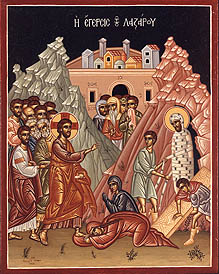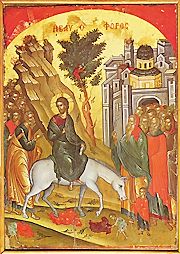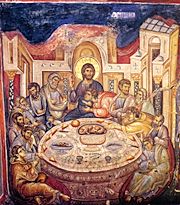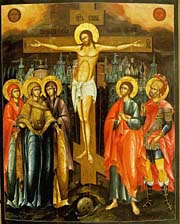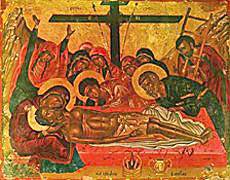Săptămâna Patimilor: Diferență între versiuni
(→Holy Wednesday: traducere) |
(→Holy Monday: traducere) |
||
| Linia 12: | Linia 12: | ||
===Palm Sunday=== | ===Palm Sunday=== | ||
The first day of Holy Week begins with [[Vespers]] of Saturday evening leading to the celebration of the services of '''Our Lord's Entry into Jerusalem''' the next morning, Sunday. In the western world this day is usually called ''Palm Sunday''. As Christ makes his triumphal entry into Jerusalem, his divine kingdom on Earth is proclaimed under the branches of the palm tree. | The first day of Holy Week begins with [[Vespers]] of Saturday evening leading to the celebration of the services of '''Our Lord's Entry into Jerusalem''' the next morning, Sunday. In the western world this day is usually called ''Palm Sunday''. As Christ makes his triumphal entry into Jerusalem, his divine kingdom on Earth is proclaimed under the branches of the palm tree. | ||
| − | === | + | ===Lunea Mare=== |
| − | + | ||
| + | Primele tri zile ale Săptămânii Patimilor (sau Săptămânii Mari) ne amintesc de ultimele porunci/sfaturi/îndrumări lăsate de Hristos ucenicilor Săi. Acestea sunt învățăturile amintite în slujba Ceasurilor (ținute după rânduiala din Postul Mare), urmate de Obedniță și de Vecernia unită cu Liturghia Darurilor mai înainte sfințite (a Sf. Grigorie Teologul). | ||
| + | |||
| + | Slujbele Utreniei săvârșită în serile Duminicii Floriilor, precum și a zilelor de luni și marți din Săptămâna Patimilor sunt grupate în jurul temei [[Mirele|Mirelui]], inspirate din Pilda celor zece fecioare (Matei 24, 1-13) care cheamă la pregătirea pentru A Doua Venire a lui Hristos, căci "în mijlocul nopții vine furul". | ||
| − | |||
===Miercurea Mare=== | ===Miercurea Mare=== | ||
În Sfânta și Marea Miercuri se săvârșește Taina [[Sfântul Maslu|Sfântului Maslu]], în amintirea ungerii lui Hristos cu mir, în Betania. La sfârșitul slujbei, preotul îi unge pe credincioși cu Sfântul Mir. Tot în această zi se pomenește vinderea lui Iisus de către Iuda (de aceea credincioșii ortodocși țin și miercurea ca zi de post de-a lungul întregului an). | În Sfânta și Marea Miercuri se săvârșește Taina [[Sfântul Maslu|Sfântului Maslu]], în amintirea ungerii lui Hristos cu mir, în Betania. La sfârșitul slujbei, preotul îi unge pe credincioși cu Sfântul Mir. Tot în această zi se pomenește vinderea lui Iisus de către Iuda (de aceea credincioșii ortodocși țin și miercurea ca zi de post de-a lungul întregului an). | ||
Versiunea de la data 7 februarie 2007 22:18
| Acest articol (sau părți din el) este propus spre traducere din limba engleză!
Dacă doriți să vă asumați acestă traducere (parțial sau integral), anunțați acest lucru pe pagina de discuții a articolului. |
Pentru creștinii ortodocși, Săptămâna Patimilor este săptămâna de la sfârșitul Postului Paștilor, de la Sâmbăta lui Lazăr până la sărbătoarea Paștilor. Se mai numește și Săptămâna Mare.
Cuprins
Istoric
Deși există puține surse care să indice modul în care era celebrată Săptămâna Patimilor în Biserica timpurie, se pare totuși că aceasta este o practică foarte veche. Deja în secolul al IV-lea celebrarea acesteia pare să fi fost deja o practică bine stabilită, structurată într-un mod asemănător celui din zilele noastre. While little is recorded of the development of the celebrations of the Holy Week during the early years of the Church, it apparently had very early origins. By the fourth century the celebration of the week appears well founded and to be similar to our celebrations today. The pilgrim Aetheria to Jerusalem in the latter part of the fourth century described the events of the week after the services of Saturday of Lazarus, "...began the week of the Pasch, which they called here the Great Week", noting the procession commemorating Christ's triumphal entry into Jerusalem on the first day of the week. It is during this week that we remember Christ's Passion and Crucifixion.
The Holy Week
As leave is taken from Great Lent with the celebration of the Saturday of Lazarus, which remembers Christ's raising of Lazarus from the dead and the promise of universal resurrection for all, a week is entered during which the church services remember Christ's last week, the Holy Week, before his crucifixion and resurrection, During this week the Matins Services for the upcoming day is celebrated the evening before, in accordance with the ancient definition that the day is from sunset to sunset.Palm Sunday
The first day of Holy Week begins with Vespers of Saturday evening leading to the celebration of the services of Our Lord's Entry into Jerusalem the next morning, Sunday. In the western world this day is usually called Palm Sunday. As Christ makes his triumphal entry into Jerusalem, his divine kingdom on Earth is proclaimed under the branches of the palm tree.
Lunea Mare
Primele tri zile ale Săptămânii Patimilor (sau Săptămânii Mari) ne amintesc de ultimele porunci/sfaturi/îndrumări lăsate de Hristos ucenicilor Săi. Acestea sunt învățăturile amintite în slujba Ceasurilor (ținute după rânduiala din Postul Mare), urmate de Obedniță și de Vecernia unită cu Liturghia Darurilor mai înainte sfințite (a Sf. Grigorie Teologul).
Slujbele Utreniei săvârșită în serile Duminicii Floriilor, precum și a zilelor de luni și marți din Săptămâna Patimilor sunt grupate în jurul temei Mirelui, inspirate din Pilda celor zece fecioare (Matei 24, 1-13) care cheamă la pregătirea pentru A Doua Venire a lui Hristos, căci "în mijlocul nopții vine furul".
Miercurea Mare
În Sfânta și Marea Miercuri se săvârșește Taina Sfântului Maslu, în amintirea ungerii lui Hristos cu mir, în Betania. La sfârșitul slujbei, preotul îi unge pe credincioși cu Sfântul Mir. Tot în această zi se pomenește vinderea lui Iisus de către Iuda (de aceea credincioșii ortodocși țin și miercurea ca zi de post de-a lungul întregului an).
Holy Thursday
Holy Thursday begins with the celebration of vespers and the Divine Liturgy of St. Basil with a Reserved Holy Communion in representation of the earthly presence of Christ realized at the Last Supper. In the evening, anticipating the Matins of Friday morning, the Holy Passion service of the reading of the Twelve Gospel is conducted. In these readings Christ's last instructions to his disciples are presented, as well as the prophecy of the drama of the Cross, Christ's prayer, and his new commandment. The twelve readings are:- Ioan 13, 31-18:1
- Ioan 18, 1-29
- Matei 26, 57-75
- Ioan 18,28 - 19, 16
- Matei 27, 3-32
- Marcu 15, 16-32
- Matei 27, 33-54
- Luca 23, 32-49
- Ioan 19, 19-37
- Marcu 15, 43-47
- Ioan 19, 38-42
- Matei 27, 62-66
Vinerea Mare
Sfânta și Marea Vineri începe cu citirea Ceasurilor Împărătești, până la Vecernia de vineri după-amiază, în timpul căreia se face amintirea coborării trupuli Mântuitorului de pe Cruce. Preotul este cel care împlinește coborârea de pe Cruce: el ia trupul Mântuitorului, simbolizat de SfântulEpitaf, de pe Cruce, îl învelește într-o pânză albă și îl duce în SfântulAltar. În timpul slujbei de seară, numită Prohodul Domnului (sau a Plângerii la mormânt), preotul ia Sf. Epitaf (pânza pe care este pictată sau brodată imaginea lui Hristos) din Altar, ducându-l, în procesiune, în jurul bisericii înainte de a-l așeza pe un fel de năsălie care închipuie Mormântul Mântuitorului. Procesiunea, urmată de credincioșii care poartă în mâini lumânări aprinse, simbolizează coborârea lui Hristos la Iad.
Sâmbăta Mare
Sfânta și Marea Sâmbătă: Se slujesc Vecernia și Sfânta Liturghie a Sf. Vasile cel Mare, cu citiri din Psalmi și cântările Învierii care amintesc de coborârea Mântuitorului la Iad, semnificând "Prima Înviere" a lui Adam și biruința asupra morții.
Pascha
Easter or Pascha, the Feast of Feasts, celebrations begins just before midnight with the singing of the Odes of Lamentation as the Resurrection Vespers begins with the church in complete darkness. As midnight approaches the priest taking a light from a vigil light within the altar passes the flame to the faithful for their candles while singing "Come ye and receive light from the unwaning life, and, glorify Christ, who arose from the dead." Then, the priest leads the faithful out of the church in procession. After circling the church either one or three times, as the procession nears the entrance door of the church, the priest leads in the singing of the hymn of Resurrection. "Christ has Risen from the dead, by death trampling upon Death, and has bestowed life upon those in the tombs" At this point the priest and faithful enter the well-lighted church for the remaining part of Vespers and the breaking of the fast with the Divine Liturgy. After conclusion of the Divine Liturgy, in many communities, the faithful retire to an agape meal to break the Fast together, and then return home as dawn arrives. Later in the day of Pascha the faithful again gather for prayer with lighted candles in a vespers service, singing the hymn "Christ is Risen from the Dead," and greeting each other joyously "Christ is Risen" and responding with "Truly He is Risen."
